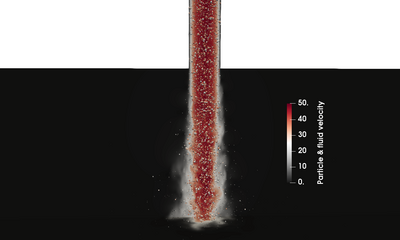Polydisperse particle-laden jet flows at high Stokes number

Dr. Armin Haghshenas
Particle-laden turbulent flows are extremely complex due to the intrinsic chaotic nature of the carrier-phase turbulence and the random character of the dispersed-phase distribution. In many applications, however, additional complexity often arises from interactions of such flows with other complex phenomena, such as evaporation, melting, and chemical reactions. Although a profound insight into many features of particle-laden turbulent flows has been gained from previous laboratory and numerical studies, characterization of such flows still remains elusive. This lack of characterization is partly because of the aforementioned, intrinsic complexity of the system and partly because of a large number of controlling parameters, namely, Reynolds number, Froude number, particle Stokes number, and mass loading.
The main objective of this project is to advance our current knowledge of relevant features of polydisperse particle-laden turbulent flows and to synthesize this new knowledge in the optimization of additive manufacturing processes. In this respect, the ability to accurately predict the carrier- and dispersed-phase behavior is of significant essence. For this purpose, we employ numerical simulations and laboratory experiments in a cooperation with the Bremen Institute for Applied Beam Technology (BIAS) to investigate polydisperse particle-laden jets with the focus on the parameter space that is relevant for additive manufacturing applications. The main characteristic of this parameter space is the moderate Reynolds number, the large particle Stokes number, the large mass loading, and the large Froude number.
For the laboratory experiments, BIAS utilizes the particle image velocimetry to accurately measure the distribution and the velocity of particles at different levels away from the nozzle exit. For the numerical simulations, we employ the Eulerian-Lagrangian method, in which the carrier phase is described as a continuum and governed by the compressible Navier–Stokes equations and the dispersed phase is described in a Lagrangian way with equations of motion for each particle. In addition, the soft-sphere model is used to describe particle-particle interactions. The numerical code has been already implemented in the open source CFD software package OpenFOAM. However, an extensive validation study using previous numerical and experimental literature is performed to assess the capability and the accuracy of the code.
In the first phase of this research, a set of numerical and laboratory experiments is designed to systematically cover the parameter space of interest for polydisperse particle-laden free jets. An analysis of the momentum and the turbulence kinetic energy budgets is performed to rationalize the results. In the second phase, deposition of particles issuing from discrete coaxial nozzles on a flat surface and the melting process through a laser beam are investigated. An optimization of several aspects of the additive manufacturing, including positions of nozzles and the laser and the mass flow of both phases, is of particular interest.


 "
"